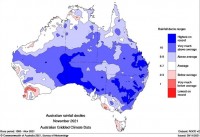Australia's wettest November on record
01/12/2021

Australia has had its wettest November since records began in 1900. It was also the country's wettest spring since 2010, according to the Bureau of Meteorology's spring climate summary.
The new Australian November average rainfall record stands at 72 millimetres, more than double the November national average of 32 millimetres. The previous November rainfall record, set nearly 50 years ago during the La Niña event of 1973, was broken by more than 2 millimetres.
The wettest day of the month was on 10 November, when Samuel Hill in Queensland received 340.8 millimetres.
Bureau of Meteorology Senior Climatologist Dr Grainger said there were a range of factors that influenced the development of storms and heavy rain across much of eastern and southern Australia this spring.
“Sea surface temperatures to the west and east of Australia have been the main influence on our wet spring. Typically, warmer waters off the north-west and north-east coast of Australia are associated with wetter than average conditions,” he said.
“At the start of spring, warmer waters to our west were associated with a negative Indian Ocean Dipole (IOD), changes of temperatures in the Indian Ocean. Later in the season, a developing La Niña event in the Pacific Ocean to our east also moved warmer waters closer to the Australian region, becoming the dominant influence on Australia's climate over the season.
"Other climate drivers contributing to an incredibly wet spring were a shift to more wet, tropical conditions over the entire continent. These are associated with the positive phase of what is known as the Southern Annular Mode and an active Madden Julian Oscillation, both global circulation patterns that influence weather systems over Australia.
"All of this has contributed to saturated soil and catchments across large parts of eastern Australia, and with a wet summer still ahead, the risk of further flooding will remain for the coming months."
Spring temperatures were above average for northern Australia, even reaching the warmest on record in some Top End regions but were below or around average for the southern states.
"November temperatures were generally below average for most of Australia, except for some parts of northern Western Australia, Queensland and the Northern Territory, which saw a warmer than average spring," Dr Grainger said.
"Overall, it was Australia's coolest November since the La Niña event of 1999, and the coolest spring overall since 2016."
Dr Grainer said with higher than usual levels of rain set to continue across parts of Australia over summer, the community needed to remain vigilant.
"We strongly encourage everyone to stay up to date with the latest forecasts and warnings on the Bureau's website, the BOM Weather app, and our social media channels."
A full breakdown of the summer outlook is available here, and an explainer of the La Niña phenomenon is available here. Technical explanations of the current outlook and associated climate drivers are available here.










